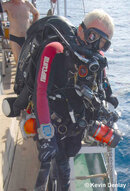Hi KWS,
Failure point, snailuer point. And
please, don't lump me in with the DIR crowd. Each to his own of course, but as Frank Sinatra sang "
I did it my way" (and that even evolved over time). IMO, some folks place waaaaaaay too much emphasis on failure points as opposed to 'what works, works', and/or learning how to solve the problem should one of those referred to 'failure points' fail.
Yeah, and again IMO, its a weak opposition argument at best.
Why? If your using doubles (and dual wings) you should only have one wing inflated (let's just say the one coming from the left post), so should your buoyancy fail you know right away which wing it is, so you just start filling the other wing (the one whose inflator hose runs over or under your right shoulder), while simultaneously shutting down the the valve to failed wing (if necessary). Same thing if you get a run-away-inflator on either wing (which
DOES need shutting down ASAP). That is, I am I assuming you were taught how to reach back and turn off either your left or right valve / post (going to the failed wing / inflator) if necessary? Which then shuts down the gas to the dead wing / run-away-inflator and wahlah, problem solved. So at least you can fix the problem, as opposed to if, in a wetsuit, and having only one wing / bladder your now SOL, and now really have a problem. Ever tried pulling yourself up hand over hand from a
deep dive using a lift bag line (with a dead single wing), steel doubles, and two or three stage bottles? Not for the faint hearted, and that lift bag better have waaaaaay more buoyancy / 'lift' than just a tubular SMB!
Seems your really fixate on failure points.
As Dirty Harry once said "
Opinions are like asxxxles, everyone's got one" (including me).
Well 'potential' yes, but as I said in my previous post, if that is so, then one can only blame oneself for habitually only using that one wing (inflated over left) and applying the good old Oztralian attitude of "
she'll be right mate" for the one on the right.

Correct, if diving with a drysuit and a wing, the wing is still my primary buoyancy, and if that should fail then I'll go to my ever so slightly inflated drysuit (that is only inflated enough so as not to be squashing my nuts).
As I said above, you seem to constantly be fixating on so-called failure points. Not a bad thing up to a point, but IMO better to learn how to solve any problem that may arise from same.
After all, you can reduce 'failure points' to a bare minimum and still have a failure.
Well, correct me if I am wrong, but that sounds like you did not flush out the bladder and then dry out same properly after the last time you used them? And / or stored wing flat in interim without being partially inflated? Like I said above, or to use the acronym, PPPPPP. And that includes checking your gear yourself / and servicing when necessary.
Agreed, and I hear you loud and clear! Hence why you should
only have your gear serviced at a
highly recommended shop / service facility.
Or better still, take your life in your own hands, as many serious divers do, and learn (take courses) in how to properly service (as much as) your own gear as you can.
But hey, I would be the last person to ram down anyone's throat what you have to / should do, just offering my POV and some suggestions (that might be far from kosher if your a DIR aficionado).
Anyway, I am still walking and talking after 30 odd years (yeah I started diving late in life) of fairly serious (and remote) diving, and you could say I was a walking failure point at times (pick em out below). But I had no serious failures that I could not handle. Not beating my chest, just saying is all, as I dived both OC and CCR (
especially CCR)
solo as much as I could.
Anyway, safe diving to you KWS.
 Postscript
Postscript: While there are many many wrong ways to do things,
there is not just one right way, as some folks / instructors would have you believe.





